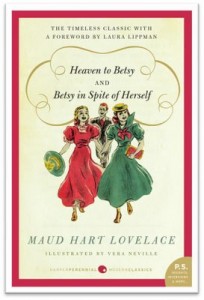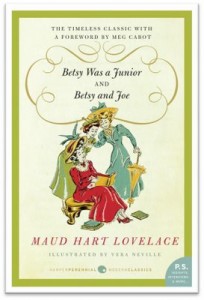I Met the Malones
 The Beany Malone books by Lenora Mattingly Weber have been recommended to me many a time over the years, usually by fellow Betsy-Tacy and Anne Shirley fans. I finally got around to reading the first in the series, Meet the Malones, and I found it enjoyable and—peculiar.
The Beany Malone books by Lenora Mattingly Weber have been recommended to me many a time over the years, usually by fellow Betsy-Tacy and Anne Shirley fans. I finally got around to reading the first in the series, Meet the Malones, and I found it enjoyable and—peculiar.
The heroine of Meet the Malones is fifteen-year-old Mary Fred Malone, older sister of Beany (christened Catherine Cecilia) who takes center stage in subsequent books. Mary Fred is a cheerful, impulsive, idealistic girl whose siblings consider her the family rock, the person whose core of strength helps others stand firm. It’s 1942 and, oh yes, there’s a war on. Mary Fred’s father is a respected newspaperman, writer of stirring editorials that challenge the citizens of Denver to dig deep, give of their time and treasure, and open their homes to soldiers, orphans, the elderly, the lonely, the friendless. Snooty Mrs. Socially-prominent Adams next door may look down on the eccentric Malones, but their warmth and generosity has earned them the affection and respect of most everyone else who knows them.
Besides Beany and Mary Fred, there is brother Johnny of the winning smile and writerly genius, and oldest sister Elizabeth, a young war bride whose arrival home is but one of the many lively events of the opening chapters. When we meet Mary Fred, she has just bought an injured horse, rashly spending the money her step-grandmother sent her for a gown for the spring formal. Leading the horse home in a blizzard, wondering how she’ll come up with the remaining fifteen dollars she owes the stable-owner, she witnesses a fender bender between her brother Johnny and a car full of eggs—dozens of eggs. The eggs belong to a farm wife from Wyoming who has been saving them, all 48 dozen of them (!), to sell here in Denver where they’ll fetch a better price. Johnny’s dream of replacing his battered old typewriter shatters like an eggshell as he tallies up how much it’ll cost to pay for the ruined eggs and the repairs to the egg lady’s car—which, as it happens, is driven by a tall and handsome (but not too handsome) young cowboy named Anders—who, as it further happens, is coming to live with his aunt, Mrs. Socially-prominent Adams while taking a premed course at the university.
This breathless pace continues throughout the book, with event after event piling on—we have spunky war refugees, and an elderly history buff with a wandering mind, and an overbearing step-grandmother, and more war orphans, and a completely unlikable big-man-on-campus whom Mary Fred inexplicably adores, and various debts, and a new baby, and a missing G.I.—and yet somehow the storytelling is always quite clear. Weber deftly weaves six or seven strands of storyline together, now this one on top, now another, tying them all together neatly (a little too neatly) at the end.
It isn’t brilliant writing, nor at all lyrical. And Weber pounds her moral home with a pretty big hammer. (All the various subplots reinforce the theme of “You don’t get something for nothing,” which is broadcast so frequently that it might as well be stitched on a sampler and hung on the wall.)
And yet—it was a delightful read. The 1940s dialogue and local color is quaint and charming, and the Malones are an entirely loveable bunch. Well, almost entirely. Mary Fred’s crush on the deplorable Dike Williams, school football hero and user of the first order, is dippy and irritating: it’s so clear to the reader that he’s a jerk, even granting allowances for the cringeworthy slang of 70 years ago. (“Hey, gal. Will you be my squaw at the party?”) Mary Fred’s blind crush on this swaggering narcissist drives a great deal of the plot, and before long you’re wanting someone to take her by the shoulders and give her a good shake.
I think I’ve read that Weber improves as the series progresses, so I’ll have to keep reading and see if the things I enjoyed about Mary Fred and kin continue to outnumber the things that made me wince.



